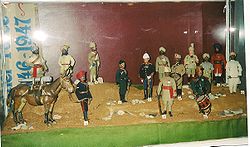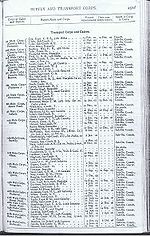Difference between revisions of "Mule Corps"
(→Historic books online) |
m (remove commercial and other internal link breaking guidelines) |
||
| Line 38: | Line 38: | ||
*[http://www.telegraph.co.uk/news/obituaries/military-obituaries/army-obituaries/5845146/Major-Victor-Warren.html Obituary of Major Victor Warren] 16 Jul 2009 ''The Telegraph''. In 1943 he commanded an Indian mule company which journeyed by train from the foot of the Khyber Pass to Karachi, sailed to Iraq and then made a 600-mile march through northern Syria to Tripoli in Lebanon; finally, it landed in Italy in 1944 to play a vital role in supplying forward infantry units with ammunition and blankets at the battle of Monte Cassino. | *[http://www.telegraph.co.uk/news/obituaries/military-obituaries/army-obituaries/5845146/Major-Victor-Warren.html Obituary of Major Victor Warren] 16 Jul 2009 ''The Telegraph''. In 1943 he commanded an Indian mule company which journeyed by train from the foot of the Khyber Pass to Karachi, sailed to Iraq and then made a 600-mile march through northern Syria to Tripoli in Lebanon; finally, it landed in Italy in 1944 to play a vital role in supplying forward infantry units with ammunition and blankets at the battle of Monte Cassino. | ||
*[http://www.telegraph.co.uk/news/obituaries/1500292/Brigadier-Hector-Wilkins.html Obituary of Brigadier Hector Wilkins 1916-2005] 10 Oct 2005 ''The Telegraph''. In 1944 He was a supervising veterinary officer of "A" Group Indian Pack Transport consisting of nearly 1,000 animals in Italy. | *[http://www.telegraph.co.uk/news/obituaries/1500292/Brigadier-Hector-Wilkins.html Obituary of Brigadier Hector Wilkins 1916-2005] 10 Oct 2005 ''The Telegraph''. In 1944 He was a supervising veterinary officer of "A" Group Indian Pack Transport consisting of nearly 1,000 animals in Italy. | ||
| − | |||
*Video: [http://www.iwm.org.uk/collections/item/object/1060030433 Evacuation of "special force" mules and men by waterborne craft made especially for the occasion] Burma WW2 contains some images of mules. Imperial War Museums | *Video: [http://www.iwm.org.uk/collections/item/object/1060030433 Evacuation of "special force" mules and men by waterborne craft made especially for the occasion] Burma WW2 contains some images of mules. Imperial War Museums | ||
| − | + | ||
| − | |||
==Historical books online== | ==Historical books online== | ||
Revision as of 13:27, 18 November 2015
Mules formed part of the supply and transport section of armies and were particularly popular with expeditionary forces which had to travel over rougher terrain. A mule driver is called a muleteer.
Contents
Mule Corps of the Indian Army
Prior to 1884 no permanent transport department was established in the Indian Army and animals, carts and drivers were hired locally when required. Between 1884 and 1887 a separate transport corps existed. This became known as the Commissariat Transport Department and was under the control of the Military Department.
However by 1905 a further reorganisation had witnessed the emergence of a regular corps and cadres of mules, camels and cart transport. "This now consists of 21 mule corps, 9 silladar camel cadres and 2 pony cart train cadres. A mule corps is commanded by a British officer and is divided into two subdivisions, each in charge of a warrant officer. Those for cavalry brigades are divided into six draught and four pack troops , each under a daffadar and have a total strength of 552 all ranks, with 936 mules. Those for use wih other arms are divided into nine pack troops, each under a daffadar, and have a total strength of 388 of all ranks with 840 mules. Cadres of mule corps are commanded by a British Officer and maintain practically the full number of supervising and artificer establishments. They have, however, a much smaller number of mules." [1]
Fibiwiki article on Mountain Guns describes the artillery that could be carried by mules
The mule corps played an integral part in the various theatres of war during the First World War such as France, Gallipoli, Egypt and Basra.
Records
Details of where the individual sections of the Mule Corps were based each year are included in the annual Indian Army Lists under the section entitled "Supply and Transport Corps". (An example page from 1905 is shown).
External links
- British Army Transport Animals Excellent article by Clive Elliott containing lots of background information about the roles played by army mules with accompanying photos and diagrams.
- The History Of The Screw Gun By Colonel J.R.M. Hubel, CD AdeC BA M Ed limbergunners.ca. Includes a section on mules (scroll down)
- At Gallipoli dring the First World War there were Four Mule Cart Corps, each comprising 650 men and 1086 mules.[2]
- Photograph of Indian troops [7 Indian Mounted [Mountain?] Artillery Bde with mules, waiting to embark transport ship at Alexandria, Egypt. No 2278. 1916 from a collection of official photographs of the Dardanelles Expedition, 1915-1916. The Serving Soldier King’s College London
- Photograph: Mule carts at Bombay docks, WW1 Scroll down to the image. mapinpub.in
- "Macedonia 1916-1918: Indian Military Transport Units in Macedonia" by Harry Fecitt, Harry’s Sideshows kaiserscross.com. Mule Corps in Salonika.
- About Mules c 1937 Extracts from the Manual of Horsemastership, Equitation, and Animal Transport 1937 - Published by Her Majesty's Stationery Office: London.
- British India Steam Navigation Company Ltd. Trooping with Richard Douglas Crow includes a short account of transporting a Mule Corps from Bombay to Marseilles in WW2
- "Force K6: Indian troops in France" by Mandeep Singh Bajwa, Hindustan Times May 19, 2013. Consisted of 22, 25, 29 and 32 Mule Companies and a supply depot, a reinforcement unit, part of an Indian General Hospital, and a remount section sent to France, reaching there in December 1939. The men were subsequently evacuated from Dunkirk and then spent time in Britain.
- In Wales: BBC North West Wales The 22nd company got captured by the Germans just before Dunkirk
- In Scotland
- From the Historylinks Museum, Dornoch in the Highlands of Scotland
- Article from the Northern Times 15/11/2002, concerning Muslim Indian Army WW2 soldiers buried at Proncynain Cemetery, Dornoch. Click on the “Open Document” at the bottom for a larger version.
- Information about the Regiments in Scotland by Hamish Johnston. Click on the "Open Document” at the bottom for page 2.
- Image of the first page of an 28 page article “A Corner of Pakistan in Scotland” by Hamish Johnston, told in two articles in the Highland Family History Society Journal 2012. It may be possible to apply to the museum (enquiries@historylinks.org.uk) for a copy in terms of the following: "pdf files of larger size may be made available, copyright permitting, for a reasonable donation to cover administrative costs”.
- The Indian Army at Loch Ewe, Scottish Highlands: russianarcticconvoymuseum.co.uk and scotsman.com
- From the Historylinks Museum, Dornoch in the Highlands of Scotland
- Listen to the 1991 interview with Francis William Geoffrey Turner British officer served as brigade animal [mule] transport officer with 111 Indian Infantry Bde during First and Second Chindit Expeditions in Burma, 1943-1944. Imperial War Museums.
- The Stubborn but Courageous Mule in Burma WW2. 14usaaf27tcs.4mg.com.
- The Mules of Mars by 1st Lt. Don L. Thrapp, Q.M.C.The Quartermaster Review May-June 1946. The Mars Task Force in Burma, 1944, USA Army. (Cached URL)
- Mules for China by Captain John A. Rand. Some were selected from other elements of the Mars Task Force. (Cached URL)
- Obituary of Major Victor Warren 16 Jul 2009 The Telegraph. In 1943 he commanded an Indian mule company which journeyed by train from the foot of the Khyber Pass to Karachi, sailed to Iraq and then made a 600-mile march through northern Syria to Tripoli in Lebanon; finally, it landed in Italy in 1944 to play a vital role in supplying forward infantry units with ammunition and blankets at the battle of Monte Cassino.
- Obituary of Brigadier Hector Wilkins 1916-2005 10 Oct 2005 The Telegraph. In 1944 He was a supervising veterinary officer of "A" Group Indian Pack Transport consisting of nearly 1,000 animals in Italy.
- Video: Evacuation of "special force" mules and men by waterborne craft made especially for the occasion Burma WW2 contains some images of mules. Imperial War Museums
Historical books online
- "Mule Transport in Persia" by C E Biddulph page 407 The United Service Magazine Volume 8 New Series October 1893 to April 1894 Archive.org. Mules were purchased in Persia by the Indian Transport Department.
- Chapter X: The Mule page 270 Animal Management 1908. Prepared in the Veterinary Department for General Staff, War Office. HMSO. Reprinted 1914 Archive.org.
- On Two Fronts - Being the adventures of an Indian Mule Corps in France and Gallipoli by Major H M Alexander DCO, S & T Corps, Indian Army 1917 Archive.org. The Mule Corps were part of the Supply and Transport Corps.
- On the road to Kut: a soldier's story of the Mesopotamian campaign with 56 illustrations and a map. 1917 Archive.org. The author appears to be an officer from India in a Mule Corps.
- "Chapter V. The Gallant Mule" page 43 The Horse and the War by Captain Sydney Galtrey, Remount Department. Illustrated with drawings by Captain Lionel Edwards 1918 Archive.org
References
- ↑ Imperial Gazetteer of India Volume 3
- ↑ "The Indian Army at Gallipoli 1915" condensed from a paper presented by Sqn Ldr Rana TS Chhina (Retd) at a conference organised by the Australian War Memorial in August 2010. Website of the High Commission of India in Australia

